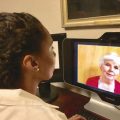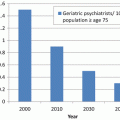Role
Sample survey questions
Referring physicians
1. Was your consultation question adequately addressed?
2. Were treatment recommendations clear?
3. Were interactions with remote staff positive and efficient?
Technical staff
1. Was adequate time allotted for equipment setup?
2. Was the set up process complicated or confusing?
3. Was IT support readily available?
Administrative staff
1. Were interactions with remote providers pleasant?
2. Were responsibilities clearly identified?
3. Were administrative steps for requesting consultations and receiving recommendations efficient?
Patient satisfaction can be difficult to obtain. Patients who are involuntarily committed to an inpatient facility due to safety concerns may report low satisfaction. Patients with neurocognitive disorders, delirium, agitation, or psychosis may not be able to appropriately answer satisfaction survey questions. Furthermore, surveying only those patients who are cognitively intact enough to understand the service and those who willingly accept treatment recommendations skews results. One alternative is to have nursing staff answer questions such as whether the patient displayed understanding of the remote nature of the evaluation, interacted adequately with the provider, and demonstrated understanding of recommendations [17].
5.1.2.11 Other Factors
These include environmental and patient-specific factors. Environmental factors include ambient lighting, noise, session privacy, and room set up. Patient-specific factors such as vision or hearing impairment may affect suitability for telepsychiatry based evaluation and management. In emergencies, glasses and/or hearing aids may not accompany the patient. To compensate, increased volume on the equipment’s speakers can exceed the typical sound attenuation (materials like walls/doors and the distance between other patients) of the evaluation area. These factors can compromise privacy. Emergency departments also often have very high levels of background noise, which can further obscure communication. When the vision-impaired patient cannot see the provider well, they may also lose non-verbal communication such as gestures (e.g., nods) facilitating continued discussion or rapport building. This may also make verbal communication more difficult as the provider’s lips cannot be read. In such circumstances, enhanced efforts on the part of the telepsychiatrist to clarify and encourage verbal response to questions may be necessary to compensate for these barriers.
Program Outcomes
Various outcome measures can be gathered to assess the success of a geriatric telepsychiatry program. These may include:
Number of patient encounters by a provider over a given time period
Time from consultation request to patient evaluation
Number of patient transfers to higher level of care pre- and post-implementation of telepsychiatry services.
Outcome measure data can be easily accessible and gathered from the EMR. Statisticians then analyze and generate outcome reports that can inform future directions of the program.
5.2 Ethical Considerations
Sabin and Skimming identified the following challenges to telepsychiatry services, particularly from an ethical perspective [23].
- 1.
Providing competent, safe care
- 2.
Ensuring informed consent
- 3.
Promoting privacy and confidentiality
- 4.
Managing boundaries
- 5.
Encouraging continuity of care
- 6.
Addressing health equity.
No matter how robust the technology, patient encounters and resulting outcomes require well-trained and diligent providers.
As there are varieties of mental illnesses faced by the elderly, as well as different settings and levels of care, so there are numerous opportunities for implementation and intervention via conventional, telemedicine, or combinations thereof. Yellowlees mentions the only contraindications from the patient’s perspective are “a refusal to take part, or current actual physical violence towards the self or others” [18]. There are some varieties of psychotic symptoms including referential thinking, which may limit or perhaps even make videoconferencing counter-therapeutic. Patients reluctant to engage in face-to-face encounters may refuse telepsychiatric assessment. An example is a patient on a psychiatric unit who was chronically concerned that she was being filmed. This inpatient refused to appear before a camera and feared there were hidden cameras continuously surveilling her actions. She required in-person assessment for these reasons.
Occasionally individuals express chagrin at not having face-to-face encounters; however, some may later become cooperative and allow evaluation when it is explained that they may not be able to leave the emergency department without an interview. Other patients view telepsychiatry from a more positive perspective . Apart from timesavings, increased access, and many benefits addressed elsewhere in this book, there are additional advantages. As noted by Yellowlees, during telepsychiatry connections, patients “feel more in control during video consultations, and can, if they wish, literally switch off the doctor at their end and leave the consultation without any physical embarrassment or loss of face.” Further, “the online relationship, in most situations, tends to be more egalitarian than that which occurs in-person” [18].
5.3 Hybrid Care
Traditional healthcare with its commute, waiting room, and de rigueur interaction can be viewed as “outmoded and inconvenient” [18]. Telehealth solutions mirror the ease and immediacy of other goods and services of the present day, particularly in the developed world.
The hybrid model often has one component at the primary care provider’s (PCP) office. Initially the patient (and sometimes family) are interviewed followed by a joint feedback session with the PCP. At the time with PCP present, the telepsychiatrist instructs the patient to tell the PCP “what their diagnosis is, and what the proposed treatment plans are.” “This is a powerful approach that shifts the locus of care away from the telepsychiatrist, as the distant expert, and back fully to patient and the PCP. It also ensures the patient understood the consultation findings” [18].
5.3.1 Telepsychiatry in Emergency Departments
Patients seeking mental health services in emergency departments (particularly in rural areas) often do not receive care from psychiatrists. Telemedicine is an elegant way to bring specialist access to remote areas and improve support and collaboration with emergency department (ED) staff. Some of these implementations have been successful and attained American Psychiatric Association (APA) Achievement Awards. Two such programs, one in Texas and the other in South Carolina, will be described.
Lufkin County Texas’s Burke Center received the 2011 APA Gold Achievement Award for its psychiatric receiving facility featuring a comprehensive range of services not usually available in rural settings. Burke Center Mental Health Emergency Center (MHEC) serves 12 East Texas counties and utilizes telemedicine. Staff onsite include mental health technicians, nurses, caseworkers, and counselors, while psychiatrists are available by either video or phone. Typically, psychiatric consultation is available via video (within 30 minutes) or via phone (usually in 5 minutes). In addition to emergency services and outpatient services, both crisis and voluntary beds are available. In contrast to needing medical clearance via all-purpose emergency departments as a gateway step preceding emergency psychiatric services, MHEC’s services can directly be accessed and if necessary, a medically unstable patient can be redirected to a local emergency department. The psychiatrists of the MHEC treat many common medical comorbidities (including asthma, “moderate” infections, diabetes, and hypertension) while simultaneously addressing the mental health component(s).
Stay updated, free articles. Join our Telegram channel

Full access? Get Clinical Tree






